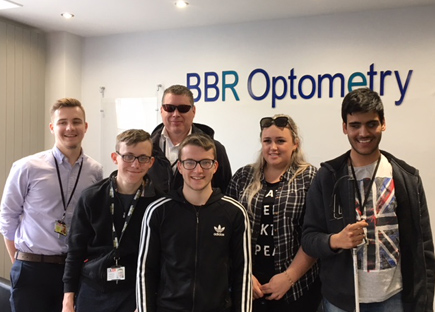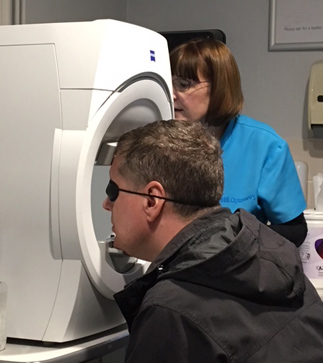
Visually impaired cricketers prepare for the 2018 season after undergoing classification at Hereford’s BBR Optometry practice
Young visually impaired cricketers, some of whom could end up playing for the England national squad, have been undergoing sport sight classification at a Hereford optometry practice in the lead up to the 2018 season.
Members of the Bulldogs, a cricket team from the Royal National College for the Blind (RNCB) at Hereford, undertook their classification at BBR Optometry in St Owen Street to ensure they can play in the North and West Regional League. The league includes teams from Lancashire, Merseyside, Worcestershire, Staffordshire and Herefordshire.
“Many of the cricket players had never played sport before, let alone cricket,” said Tom Bendall, Outreach and Events Officer at the RNCB. “So, being able to participate is a great way for them to develop their sports skills and be part of a team.”
“Each player has to receive a classification based on their visual impairment. It ranges from totally blind to partial sight. Each team is limited to a certain number of players from each category playing in each match and so the classification is important.”
BBR Optometry undertakes eyesight tests to the British Blind Sport body classification.

The practice has also undertaken classifications for football players from the National Partially Sighted Football team (administered by the FA) and the England Blind football team as well as Goal Ball.
RNCB, which is the UK’s leading Further Education College for those aged over 16 with visual impairment, plays in the regional league set up by Blind Cricket England and Wales Board and is affiliated to the England and Wales Cricket Board which oversees all league and national cricket in England and Wales.
It has two students who play for the England national visually impaired cricket team.
Nick Rumney, chairman of BBR Optometry, said the practice was proud to be helping blind and partially sighted young people into sport.
“Sport can be undertaken by everyone, no matter what your background or ability. The sight classification of members of the Bulldogs and other teams means they can not only play cricket, but they have a chance to play in the regional and national leagues as well as possibly getting into the England team,” he said.
“Perhaps more importantly it means they have an opportunity to take part in sport and at a level they might not have thought possible. Many players hadn’t played sport of any kind before. So, it’s really great to be part of this and ensuring they can follow their dreams.”
The ophthalmic practice undertakes sight tests of each player and registers their sight impairment according to IBSA criteria. Each visually impaired cricket team has to have a certain number of players from one of four levels of sigh impairment during each match.
Scoring in blind cricket is determined by each players sight classification. For example, a totally blind player (B1 sight category) can only be bowled with a minimum two bounces before the wicket and a partially sighted player can be bowled just receiving one bounce before the wicket. A totally blind player receives double runs when it comes to batting and would have a team mate running for them
The Bulldogs, which has a squad of between 18 and 20 members opened the season last weekend (28/29 April) with matches against Lancashire and Merseyside.
The college has students from throughout England and Wales. More details can be found at www.rnc.ac.uk.